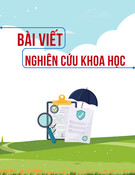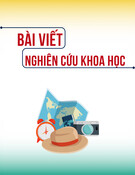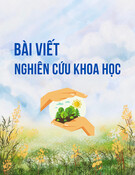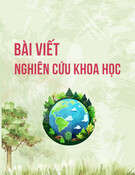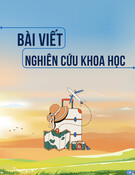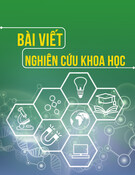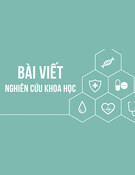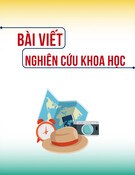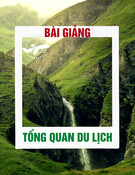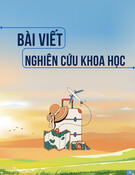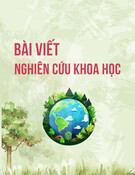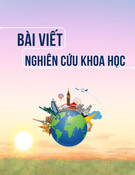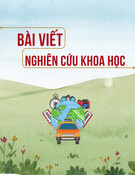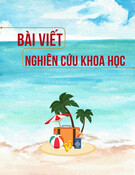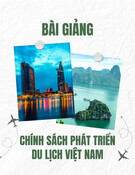
KINH NGHIỆM THỰC TIỄN
145Volume 14, Issue 1
SUSTAINABLE RURAL DEVELOPMENT THROUGH
AGRITOURISM IN BEN TRE PROVINCE
Phan Thi Ngana; Truong Phuc Haib
The sustainable development of rural areas is a critical goal for many countries, and Vietnam is
no exception. Ben Tre province, with its rich agricultural heritage, facing challenges in securing
sustainable income for farmers who rely solely on farming. These difficulties have further been aggravated
by the impacts of climate change, thus demanding alternative means of livelihood. In recent years,
agritourism, which combines agricultural production with tourism functions has been introduced with
the aim of promoting sustainable development and implementing the green development strategy of Ben
Tre province. This approach is particularly suitable for the three districts of Chau Thanh, Mo Cay Nam
and Thanh Phu. By associating economic, social, and environmental aspects of sustainability, agritourism
represents an innovative and diversified strategy for rural areas. Developing agritourism is considered a
promising solution to generate income, revitalize landscapes and contribute to social values for farmers.
Therefore, agritourism could potentially create a sustainable and resilient economic future for the local
community of Ben Tre province, thereby helping to preserve the cultural heritage and natural resources
of the region. The present study explores the potential of agritourism as a tool for sustainable rural
development in Ben Tre province and proposes strategies for its successful implementation.
Keywords: Agritourism; Sustainable development; Rural areas; Ben Tre province; Climate change.
Nguyen Tat Thanh University
Email: aptngan@ntt.edu.vn; btphai@ntt.edu.vn
Received: 28/11/2024; Reviewed: 08/12/2024; Revised: 11/12/2024; Accepted: 03/01/2025; Released: 28/02/2025
DOI: https://doi.org/10.54163/ncdt/395
1. Introduction
The Mekong Delta is prone to climate changes,
such as saline water intrusion and severe flooding
caused by rising sea level. The high salinity
level is expected to severely damage the paddy
fields and the widely developed fruit farms in
the central and upstream areas. According to the
Japan International Cooperation Agency (JICA)
report, the cost of damage in Ben Tre province was
regarded as the highest out of the seven coastal
provinces (JICA, 2016). Furthermore, despite the
potential advantage of agriculture, the income
of farmers has remained low, which proves that
agricultural economy does not guarantee the living
standards of the local people. A report from the
General Statistics Office of Vietnam has shown that
the per capita income of Ben Tre province in 2021
is only 3,367 million VND per month, ranking
in the 9th position in the Mekong Delta. Thus, it
is necessary to have a new, long-term, sustainable
option for farmers’ livelihoods. As agritourism
is built on the basis of indigenous factors, the
agro-economy, traditional culture, and the natural
environment, the agricultural production activities
of the farmer could be long-lasting and open.
In this paper, the potential of agritourism
was investigated as a tool for sustainable rural
development in Ben Tre province. The present
study aims to identify the key factors that
contribute to the success of agritourism initiatives,
including the integration of economic, social, and
environmental components of sustainability. By
analyzing case studies and conducting interviews
with stakeholders, some strategies have been
proposed for the successful implementation
of agritourism in the region. Our findings
have important implications for policymakers,
development practitioners, and farmers seeking
to promote sustainable rural development in the
Mekong Delta region and beyond.
2. Overview of issues research
Agritourism has been studied by researchers
around the world for a long time. Agritourism
thrived in the 1980s and 1990s of the last century.
Previously, Mormont (1987), Nitsch and der
Straaten (1995) and Hjalager (1996) studied
how rural tourism in Europe developed over the
course of a century with lessons learned. The term
agritourism is being replaced by farm tourism,
rural tourism, farm-based tourism or green tourism.
Barbieri and Mshenga suggest that an activity
developed on the farm with the aim of attracting
tourists is agritourism (C. Barbieri, M. Mshenga,
2008, 48). Meanwhile, Hegarty and Przezbórska
(2005) emphasize on- and off-farm activities in rural
contexts as agritourism. Similarly, Julia Sharpley
and Richard Sharpleys show that agritourism is
directly connected to the agricultural environment,
products, or accommodations. The two authors
proposed that apart from farm/farm-based tourism,
agritourism also includes cultural events, museums,
craft shows, and festivals. Therefore, agritourism is

KINH NGHIỆM THỰC TIỄN
146 February, 2025
synonymous with rural tourism (Richard Sharpley,
Julia Sharpley, 1997, 9).
In another aspect, E. Curtis (2008) gave an
overview of agritourism, showed some results
obtained from Vermont and Kentucky and proposed
a model for developing agritourism for farms in the
U.S. In Rural Tourism and Sustainable Business,
Hall, Kirkpatrick and Mitchell (2005) provided
conceptual thinking and good examples of the
correlation between agritourism and sustainable
development. In their work Agritourism, Sznajder,
Przezbórska and Scrimgeour (2009) presented the
definitions and diversity of agritourism through
various topics such as agricultural economics, rural
development, marketing, rural policy, available
products and services, and characteristics of the
agricultural sector.
George, Mair and Reid (2009) analyzed several
factors affecting the development of agritourism
in modern life. The study investigated the changes
in the consumer needs of tourists as one of the
determining factors for the success of the rural
tourism program. Next, Phillip, Hunter and
Blackstock (2010) proposed a model to define
agritourism based on three criteria: (a) the nature of
the contact between the tourist and the agricultural
activity; (b) whether the product is based on
agriculture; and (c) the level of authenticity in
the travel experience. Torres and Mómen (2011)
showed particular cases of the interface between
agriculture and tourism, examined the effects of
rural restructuring and analyzed the implications of
production and consumption. The work of Sidali,
Schulze and Spiller (2011) was a valuable source of
information on agritourism, sustainable tourism and
the marketing of local food. The authors presented
marketing strategies and provided ideas about rural
tourism in tourism research. Through debates and
practical examples, the authors outlined several
ways in which culinary and cultural heritage can be
incorporated into agritourism.
Rambodagedara, Silva and Perera (2015)
examined the potential of agritourism developing
as an additional source of income for the farming
community. The objective of the work revolved
around the following issues: (1) identifying
opportunities to promote agricultural tourism in
the farming community; (2) examining the status
of agritourism in the farming community and the
possible agritourism activities to improve their
livelihoods; and (3) finding out the challenges
and problems in the development of agritourism
by farmers in the current context. Hall, Roberts
and Mitchell (2016) presented a historical guide
and the establishment of a business in a rural
area to fully meet the requirements of providing
unique experiences worth the expense of tourists.
At the same time, the authors highlighted the
main directions of advertising in the national and
international markets. Slocum (2017) discussed
three important themes: rural-urban connectivity,
agritourism-urban intersections, and strategies for
sustainable tourism development. The author has
demonstrated that increasing the participation of
local and rural communities, especially the poor,
in the chain of tourism activities will contribute
to the development of the local economy, poverty
alleviation and economic and social resilience.
Oriade and Robinson (2017) showed how policy
issues, community benefits and sustainable
development in all sectors in the locality affect
agritourism businesses. Thereby, they analzsed
the opportunities and challenges for the tourism
industry and proposed management and marketing
strategies for agritourism.
Through the study of domestic documents,
numerous efforts have been proposed for the
development of agritourism from different
perspectives. Particularly in Ben Tre, many
research projects on the province’s tourism. As for
the type of agritourism, Hanh, D.T.M. and Tien,
M. B. (2020), with the topic “Studying the model
of agricultural tourism in Ben Tre: present and
future”, have shown that there are four types of
agritourism business models in Ben Tre: (1) private
capital; (2) whole community participation; (3) one
household or a few participating households; (4)
outside investors. The authors also proposed two
types of cross-linking models in the agritourism
business, namely Corporations and Associations.
Khanh, H.T.V. (2021) analyzed the situation and
solutions of the supply chain of rural tourism
services in order to improve the lives of the people
here through tourism activities in Cho Lach
District, Ben Tre province. This study shows that
the supply chain of local rural tourism services
would help tourism strategists see the need for
economic restructuring, thereby providing more
job opportunities for people and improving family
livelihoods from rural tourism, contributing to the
local budget and increasing income for farmers
from business and service.
Overall, the literature suggests that agritourism
can be an innovative and diversified strategy
for sustainable rural development, linking
economic, social and environmental components
of sustainability. By promoting agritourism, it is
possible to generate income, revitalize landscapes
and contribute to the preservation of cultural
heritage and natural resources. However, successful
implementation requires careful consideration of
factors such as community participation, policy
frameworks, marketing strategies and supply
chain management.
3. Approaches and research methods
This study employed a three-stage methodology.
In the first stage, a comprehensive literature review
was conducted to provide an overview of relevant
literature. Qualitative data collection methods
such as observations, field trips, semi-structured

KINH NGHIỆM THỰC TIỄN
147Volume 14, Issue 1
interviews and photography were also employed.
To survey and evaluate tourism resources, cameras
were used to capture images and videos, which
were then used to develop tourist information maps.
These maps and images helped the researchers and
stakeholders design travel programs and tours that
corresponded to these resources. Once sufficient
data was collected, all team members engaged in in-
depth discussions and exchanges to develop high-
quality agritourism products and services.
The second stage involved data collection.
To gather appropriate information for different
audiences, questionnaires were designed and
distributed to farmer households, tourists and travel
companies. The farmer questionnaire consisted of
51 questions organized into two sections: profile
(questions 1-13) and agricultural/tourism activities
(questions 14-51). The travel company questionnaire
included 33 questions: profile (questions 1-5) and
tourism/agritourism business (questions 6-33). The
tourist questionnaire was also organized into profiles
(questions 1-8) and tourism/agritourism activities
(questions 9-29). The questions about general
information were designed to gather characteristics
of individuals and businesses participating in
the questionnaire, such as full name, occupation,
gender, age, education level (for the visitor and
farmer questionnaires), company name, business
field, website and company address. The remaining
questions were focused on tourism activities, and
some questions used a Likert scale to gather reviews
and comments from farmers, companies and
tourists. The main scales used in the questionnaires
were: 1) Using most of the questions to consider
the possibility of developing an agritourism model;
2) The questionnaire was given in the form of an
inquiry into the potential of Ben Tre agritourism
and the expectations of stakeholders when coming
to Ben Tre tourism. Some Likert scale questions
were also included: tourists were asked to indicate
the appropriate level of agreement with statements
related to their expectations for Ben Tre agritourism;
tour operators and farmers were asked to assess
the potential to develop agritourism, ranging from
“strongly agree” to “totally disagree”.
In the third stage, data analysis and treatment
were carried out using SPSS. The quantitative
results were processed by the SPSS program in
several ways: (1) The majority of frequencies
(percentage) were used to determine the statistics; (2)
Qualitative variables were disaggregated according
to characteristics; (3) Percentages by division
were used to compare and categorize opinions,
thereby identifying tourism trends. The tourist
survey was divided into seven groups of criteria:
natural resources; high-tech agriculture elements;
natural and social environment; cultural and
culinary elements; infrastructure; tourism services
and prices; and guiding activities and tourist care.
The farmer survey was divided into eight factors:
accommodation and security in Ben Tre; ecology,
culture and people of Ben Tre; infrastructure in
Ben Tre; Ben Tre high-tech agritourism resources;
natural landscape and cuisine of Ben Tre; evaluation
of services and tourism prices; assessment of
traditional culture and profession; and the socio-
cultural environment of Ben Tre. The tourist survey
was divided into five factors: available tourism
resources of Ben Tre farmers; tourism resources in
terms of local infrastructure and culture; tourism
resources through learning and links; tourism
resources through scientific and technological
development; and tourism resources related to
accommodation.
4. Research results
A survey was conducted among 50 travel
companies, 217 tourists, and 142 farmer
households, focusing particularly on farmers in
Thanh Phu, Mo Cay Nam and Chau Thanh districts.
The results demonstrate that climate change has
had a significant impact on agricultural production
and local livelihoods in Ben Tre province. Notably,
only 24.3% of surveyed households reported being
unaffected or minimally affected by climate change.
In contrast, over 75% of households acknowledged
varying degrees of negative impact, with categories
including affected (17.9%), greatly affected (35%)
and seriously affected (22.9%). These findings
highlight the pervasive and severe challenges posed
by climate change to the agricultural and rural
communities in the region, underscoring the need
for effective mitigation and adaptation strategies.
Combining agricultural production and tourism
functions provides a dual livelihood option that
can improve sustainability for farmers in Ben
Tre, especially those in the Chau Thanh, Mo Cay
Nam and Thanh Phu districts. The survey of 50
common travel companies in Ben Tre revealed
that the majority of respondents believe tourism
development provides a new livelihood option
(64%) and a long-term sustainable development
opportunity for farmers and rural areas (78%).
Moreover, they noted that tourism development can
generate economic benefits from agriculture (70%),
contribute to environmental protection (40%) and
help address the impacts of climate change (40%).
Agritourism can provide three main benefits to
destinations: (1) increased motivation for tourists to
choose a particular destination; (2) local economic
development; and (3) preservation of the cultural
identity of local agricultural practices. According
to the survey results, travel companies consider
the benefits of farmers’ participation in agritourism
to be significant, including promoting agricultural
products (chosen by 86% of respondents,
accounting for 26.5% of companies that completed
the questionnaire), increasing income (62%) and
helping visitors gain a better understanding of
agriculture and rural culture (68%). The specific
survey results for this topic group are as follows:

KINH NGHIỆM THỰC TIỄN
148 February, 2025
Table 1. The benefits of agritourism
The benefits of
agritourism
Responses Percent/
Cumulative
totals
Frequency Percent
Accelerating
income31 19.1% 62.0%
Promoting the
products and
agricultural
products of the
province
43 26.5% 86.0%
Helping
visitors better
understand
agriculture and
rural culture
34 21.0% 68.0%
Creating
financial
resources and
protecting
natural
resources
20 12.3% 40.0%
Creating
opportunities
for economic
development
to spread in the
community:
accommodation,
shopping
25 15.4% 50.0%
Other 9 5.6% 18.0%
Total 162 100.0% 324.0%
The survey findings highlight three primary
motivations driving travel companies (accounting
for 95% of responses) to collaborate with farmers
in developing agritourism. Specifically, 35% of
respondents emphasized Ben Tre’s predominantly
rural and agricultural landscape as a key factor,
30% identified the potential to effectively utilize
idle labor resources and another 30% underscored
the opportunity to capitalize on natural resources
for tourism development. Furthermore, the
survey identified the three most significant factors
contributing to the advancement of agritourism in
Ben Tre as perceived by travel companies. Food
services emerged as the leading factor, cited by
70% of respondents, followed by the availability
of agricultural products (52%) and the presence
of craft villages (46%). These results underscore
the importance of integrating local resources
into agritourism strategies to maximize its
developmental potential.
The survey results highlight the key criteria
that influence visitors’ preferences for agritourism
in Ben Tre, with nature and food emerging as
the most significant factors. Specifically, 69.4%
of respondents emphasized the importance
of experiences associated with nature, while
59.7% identified food as a major attraction.
Other factors, such as accommodation (38.9%),
entertainment (21.3%) and transportation (19.4%)
were considered less influential by visitors. These
findings underscore the central role of natural
and culinary elements in shaping the appeal of
agritourism, reflecting visitors’ expectations for
authentic and immersive rural experiences.
Table 2. Factors of agritourism development
Factors of
agritourism
development
Responses Percent/
Cumulative
totals
Frequency Percent
Accommodation21 11.3% 42.0%
Food and
beverage 35 18.8% 70.0%
Agricultural
commodities 26 14.0% 52.0%
Craft villages 23 12.4% 46.0%
Festival 19 10.2% 38.0%
Health tourism,
resort 21 11.3% 42.0%
Eco-tourist spot 23 12.4% 46.0%
Other 18 9.7% 36.0%
Total 186 100.0% 372.0%
The analysis of tourism activities in Ben Tre
reveals that visitors predominantly engage in
experiences centered around agricultural settings
and riverine landscapes. Among the surveyed
activities, the most frequently mentioned was
enjoying local fruits and products, which attracted
68.2% of respondents. This was followed by
visiting islands and isles (59%), participating in
boat trips along rivers to explore the islands (53%),
canoeing along canals (50.7%) and engaging in
activities such as planting and caring for trees
(40.1%). Additionally, activities such as visiting
historical and cultural sites (61.3%), enjoying forms
of Southern amateur music (44.7%) and harvesting
fruits (40.1%) were also notable preferences among
tourists. Other activities, including purchasing
local agricultural products and souvenirs and
fishing, were less common but still contributed
to the diversity of visitor experiences in Ben Tre.
These findings underscore the appeal of integrating
natural and cultural resources into the region’s
tourism offerings
In the context of agritourism, cuisine based on
agricultural production is a significant highlight of
Ben Tre province, particularly in the Chau Thanh,
Mo Cay Nam and Thanh Phu districts. Food-related
programs and agricultural activities are the two most
popular choices for tourists when visiting Ben Tre,
accounting for 76.3% and 45.6% of respondents,
respectively, (Table 3).

KINH NGHIỆM THỰC TIỄN
149Volume 14, Issue 1
Table 3. Agritourism activities you want to
experience when traveling to Ben Tre
Agritourism
activities
you want to
experience
when traveling
to Ben Tre
Responses
Percent/
Cumulative
totals
Frequency Percent
Agricultural-
related programs98 21.9% 45.6%
Foods 164 36.6% 76.3%
Accommodation
service 63 14.1% 29.3%
Agricultural
education 53 11.8% 24.7%
The sale of
agricultural
products
70 15.6% 32.6%
Sum 448 100.0% 208.4%
According to the survey results, the prices
of goods and services at destinations in Ben Tre
are considered relatively affordable compared
to neighboring provinces. Goods are attractively
displayed with clearly listed prices and there is no
evidence of solicitation or price bargaining. Cost
is one of the key factors that make agritourism
appealing to tourists. The survey findings indicate
that the majority of tourists (85.6%) rated the cost
of agritourism as reasonable. A smaller proportion
of respondents perceived the costs as high (5.6%) or
low (8.8%). These results highlight the competitive
pricing as a significant advantage of agritourism in
Ben Tre, contributing to its ability to attract visitors
and enhance their overall travel experience.
One of the distinctive features that attract
tourists to Ben Tre is the local community. Survey
results reveal that 69.6% of tourists express high
satisfaction with the simplicity and authenticity
of the local people, considering it a key positive
aspect of their visit. This perception is echoed by
travel companies, who emphasize the enthusiasm,
hospitality and honesty of the locals as notable
advantages of farmers’ involvement in agritourism.
Additionally, farmers’ participation in agritourism
is seen as valuable for several reasons. Their
enthusiasm and hospitality are highlighted as
the most significant attributes (27.3%), followed
by their honesty (22.7%). The availability of the
natural landscape (18.2%) and farmers’ passion for
agricultural cultivation, along with their ability to
preserve and share traditional culture (13.6% each),
further enhance the appeal of agritourism in Ben
Tre. These characteristics underscore the essential
role of the local community in creating an authentic
and welcoming experience for visitors.
5. Discussion
Harnessing Ben Tre’s rich ecosystems for
sustainable agritourism development
Ben Tre province, which is graced by the
alluvium-rich waters of the Ba Lai River, Tien
River, Co Chien River and Ham Luong River, is
well-recognized for agricultural and agritourism
development, particularly in Thanh Phu, Mo Cay
Nam and Chau Thanh districts. The abundant
resources, along with a significant emphasis on
land, play a pivotal role in driving agricultural
productivity. According to the Statistical Yearbook
of Vietnam 2021, approximately 57% of its natural
land is used for agriculture expanse, thus making
agricultural activities the mainstay of the local
economy. The agricultural landscape is diverse,
ranging from orchards, paddy fields and shrimp
farming to suit the agro-ecosystem conditions of
each region.
Ecosystem of paddy fields: Thanh Phu districts
provide a paddy ecosystem for vital services such
as food and livelihood provision. Furthermore,
paddy fields contribute to air purification, offer
potential for untapped tourist services and support
land reclamation attempts.
Ecosystem of orchards: Ben Tre province boasts
the Mekong Delta’s largest area of green-skinned
pomelo plantation and holds ’the coconut plantation
expanse of the country. The diverse array of fruit
trees presents an attractive investment opportunity
for agriculture-related tourism. Chau Thanh district
witnesses an 8029-hectare coconut cultivation area
alongside a 7845-hectare orchard. Similarly, Thanh
Phu district encompasses around 8125 hectares of
coconut trees, of which over 752 hectares follow
organic practices. The largest coconut gardens are
located in Mo Cay Nam district’s ecosystem, with
an estimated 16830 hectares and 4760 hectares of
which are certified organic. Moreover, an additional
2110 hectares of the district is dedicated to other
orchards. Orchards serve as providers of various
ecosystem services, encompassing food, drinks,
livelihoods, furniture, fine art, air purification
and cultural experiences such as ecotourism,
community-based tourism, and participation in
festivals. They also contribute to land reclamation
and support agricultural production.
Ecosystem of estuaries and mangroves: The
abundant freshwater resources of Ben Tre province
is considered excellent for the aquatic processing
industry in Mekong Delta. The various water
salinity levels, ranging from freshwater, brackish,
to salty water, form a diverse environment for a
wide range of animal species, unlocking substantial
agritourism potential. The estuaries in Ben Tre
province serve as ideal locations for coastal fishing,
primarily concentrated in high seas, coastal areas
and estuaries. Mangroves play a pivotal role in
regulating the microclimate of coastal and riverside
regions and support extensive and intensive shrimp
farming. In 2022, an estimated of 3500 and 450
hectares in Thanh Phu and Mo Cay Nam districts
is dedicated to shrimp farming, mainly focusing

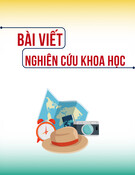
![Đề cương ôn tập Bản đồ du lịch [năm hiện tại]](https://cdn.tailieu.vn/images/document/thumbnail/2025/20250809/dlam2820@gmail.com/135x160/53061754884441.jpg)
